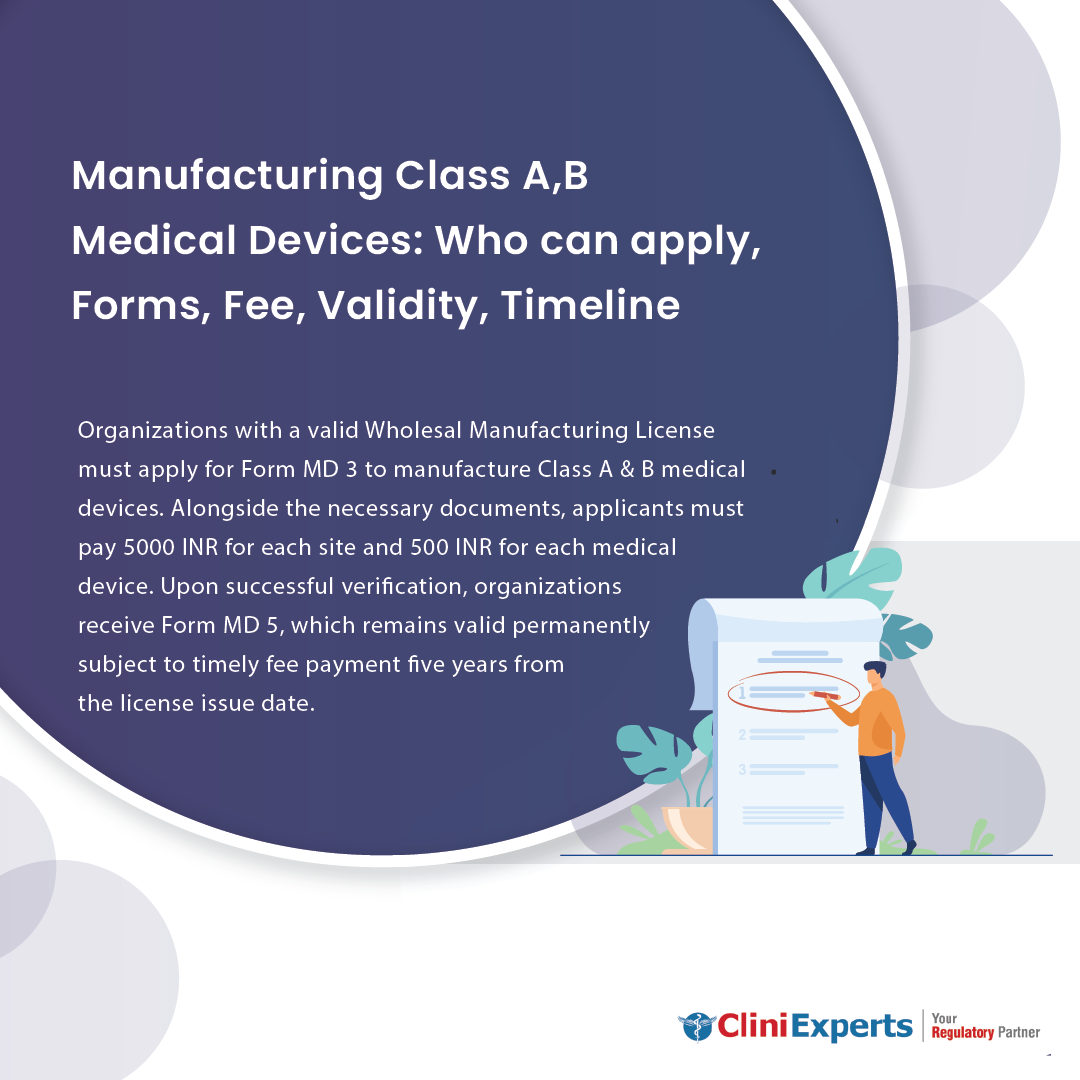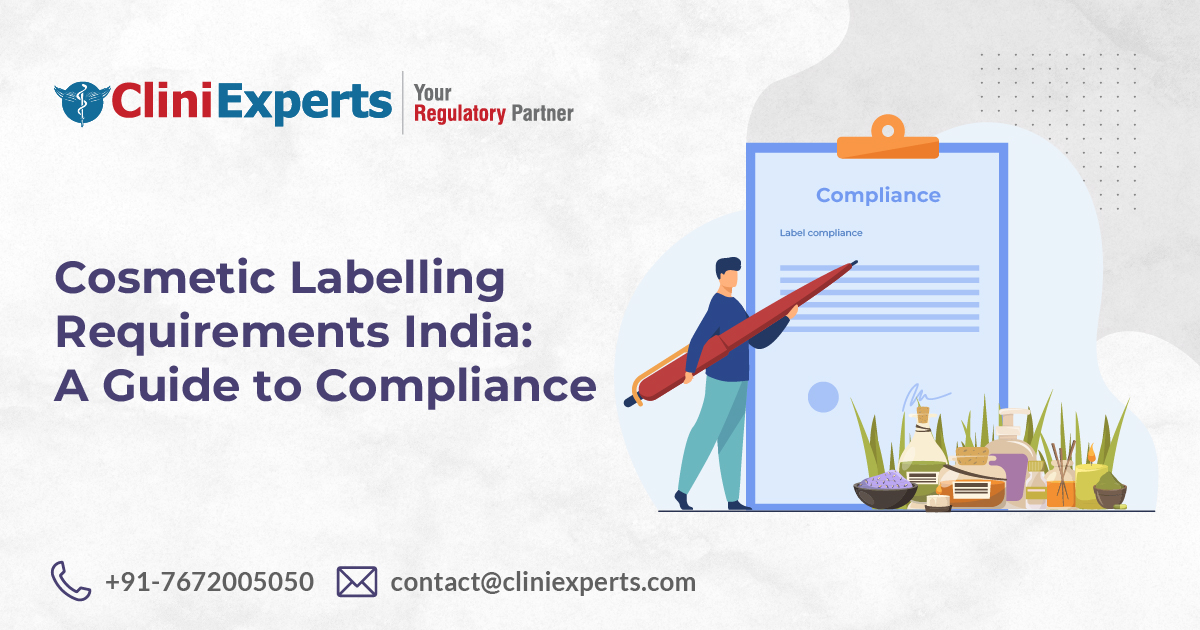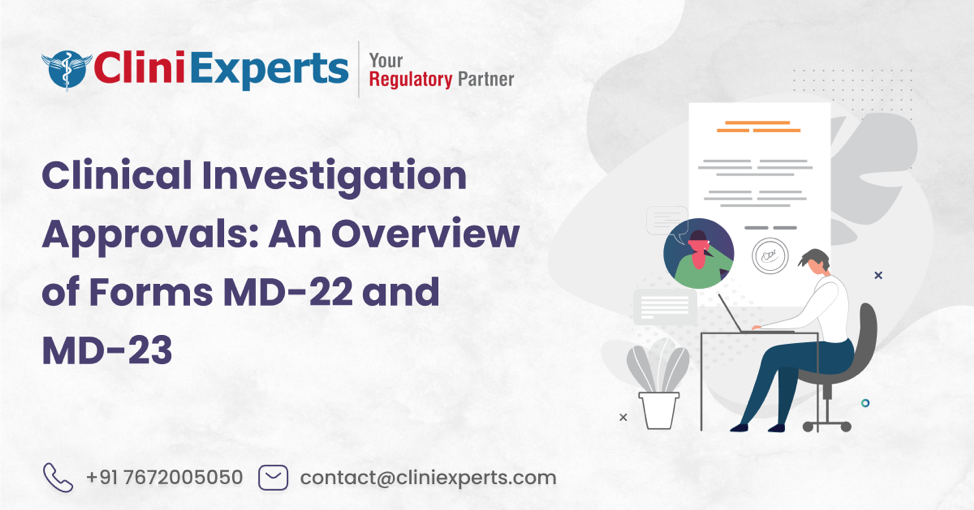Manufacture Class A-B Medical Devices: Who can apply, Forms, Fee, Validity, Timeline

What are Class A-B Medical Devices?
A medical device is a product that can be used alone or in combination with another products to diagnose, relieve, treat, or prevent diseases in humans or animals. Class A-B Medical Devices are minimal to low-risk medical equipment’s on health.
On 17 October 2017, the Central Drugs Standard Control Organisation (CDSCO) published the Medical Devices Rules, 2017 (MDR, 2017), which primarily focuses on quality and safety control to ensure the highest standards of all medical devices launched in the Indian market. As per the regulation, medical devices used for diagnosis are classified based on their level of risk and described as:
Class A medical devices are low-risk devices with minimal or no invasiveness (like thermometers)
Class B medical devices are low-to-moderate risk devices with minimal invasiveness (like needles and suction cannula).
Who can apply to manufacture Class A-B Medical Devices?
Any manufacturing company or an authorised manufacturer who holds a valid Wholesale Manufacturing License and wishes to manufacture Class A & B medical devices for sale or distribution in the country can apply for Permission to Manufacture Class A & B Medical Devices.
How to apply?
The CDSCO has appointed the State Licensing Authority (SLA) as the competent authority for granting Permission to Manufacture Class A & B Medical Devices. The State Licensing Authority is authorised to enforce all norms and regulations related to the sale, manufacturer, stock, and other practices concerning Class A and Class B medical devices. However, Class A medical devices do not require to be licensed and remain self-regulated as per MDR, 2017.
The manufacturer should make an application to the SLA in Form MD-3 for obtaining the Grant of License to Manufacture for the sale and distribution of Class A or Class B medical devices.
The following list of documents that need to be submitted along with the application are:
- A cover letter
- A copy of rightly notarised valid copies of the Quality Certificate related to the manufacturing site
- Test License received for testing and generation of quality control data
- Constitution detail of the firm- the Establishment/ Tenancy Agreement/ Site ownership
- Device Master file, Plant Master file, Performance Evaluation Report
- A signed undertaking mentioning the manufacturing site complies with the provision of the Fifth schedule.
- SMF
The approval process involves reviewing the application form by SLA. In addition, a Notified Body is appointed to conduct an audit of the manufacturing site for Class A and Class B medical devices. Upon successful auditing, the SLA issues the Manufacturing license in Form MD-5.
Forms:
The forms required for obtaining Permission to Manufacture Class A & B Medical Devices are:
Form MD 3– It is the application form that the manufacturer must submit for the Grant of License for sale and distribution for Class A or Class B medical devices.
Form MD 5– It is the final License obtained from the CDSCO for the sale or distribution of Class A and Class B medical devices upon the complete screening of all documents and approval.
Fee:
The CDSCO has defined the application fees for each category of medical devices. The charges are as follows:
- For one manufacturing site of Class A or Class B medical devices, the charges are 5000 INR.
- For each Class A or Class B medical device, the charges are 500 INR.
Validity:
Permission to Manufacture Class A & B Medical Devices/ Grant of License is obtained as Form MD-5 issued by SLA. The license is valid permanently, subject to timely completion of payment before five years from the date of its issue by the SLA. However, the license might get cancelled or suspended by the SLA based on competent reasons at any point in time.
Timeline:
The application for obtaining the Grant of License for manufacturing, sale or distribution of Class A and Class B medical devices involves a tedious list of processes, forms and paperwork. First, the SLA thoroughly scrutinises the application (Form MD-3). Then, a Notified Body is appointed to conduct an audit of the manufacturing site. And only after success in the audit the SLA issues the Manufacturing license. Thus, the overall process takes approximately 4-5 months to receive the manufacturing license.
Summary:
- A medical device is a product used for human or animal diagnosis, treatment or prevention of diseases.
- According to the Medical Devices Rules, 2017, medical devices are classified into four categories- Class A to Class D based on their risk.
- Class A and Class B medical devices come under the category of low-to-moderate risk.
- The State Licensing Authority is the appointed competent authority for this service.
- The application for the manufacturing license must be made through the identified online portal in Form MD-3 and the Grant License is issued in Form MD-5.
- The timeline to receive the Class A and Class B manufacturing license is 4-5 months
References:
- Permission To Manufacture Class A B Medical Devices (Form MD 3, MD 5) -CliniExperts [Internet]. [cited 2022 23 Aug]. Available from: https://cliniexperts.com/india-regulatory-services/medical-device/for-manufacturers/permission-to-manufacture-class-a-b-medical-devices-form-md-3-md-5/
- Medical Device Regulations For Manufacturers -CliniExperts [Internet]. [cited 2022 23 Aug]. Available from: https://cliniexperts.com/india-regulatory-services/medical-device/for-manufacturers/
- Medical Devices Rules, 2017: An Overview -CliniExperts [Internet]. [cited 2022 23 Aug]. Available from: https://cliniexperts.com/medical-devices-rules-2017/
Saurangi is a food regulatory expert with 8 years of experience. She shares her knowledge and insights on regulatory updates, food trends, best practices, and news. Follow her for expert insights and practical advice on all things for food regulatory
Saurangi Shah
CliniExperts Services Pvt. Ltd.
Recent Posts
Organic Food Labelling In India| Certification, and Import of Organic Food in India

This Article is All About Organic Food Labelling In India and Certification, and Import of Organic Food in India. Explained in Detail About What is Organic Food labelling? Summary Short Description Wi..
Cosmetic Label Compliance India : A Guide to Compliance

Introduction Looking for Cosmetic Label Compliance India? Are you a cosmetic manufacturer or importer navigating the complex world of Indian regulations? Ensuring your product labels comply with the l..
Clinical Investigation Approvals: An Overview of Forms MD-22 and MD-23

Summary Short Description Strict regulatory protocols govern clinical investigations for medical devices. Central to this process are forms MD-22 and MD-23. Form MD-22 is an application to Central Lic..
HAVE A QUERY?
REACH US!Office
New Delhi
Unit No. 324 & 325, City Centre Mall, Plot No. 5, Sector 12, Dwarka, India - 110075
+917672005050
Bengaluru
RMZ Galleria, 1st floor, Ambedkar Colony, Yelahanka, Bengaluru, Karnataka, India – 560064
Call us on
Sales: +91 7672005050
Reception: +91-11-45214546
Timings
9 am to 6 pm (Monday to Friday)


